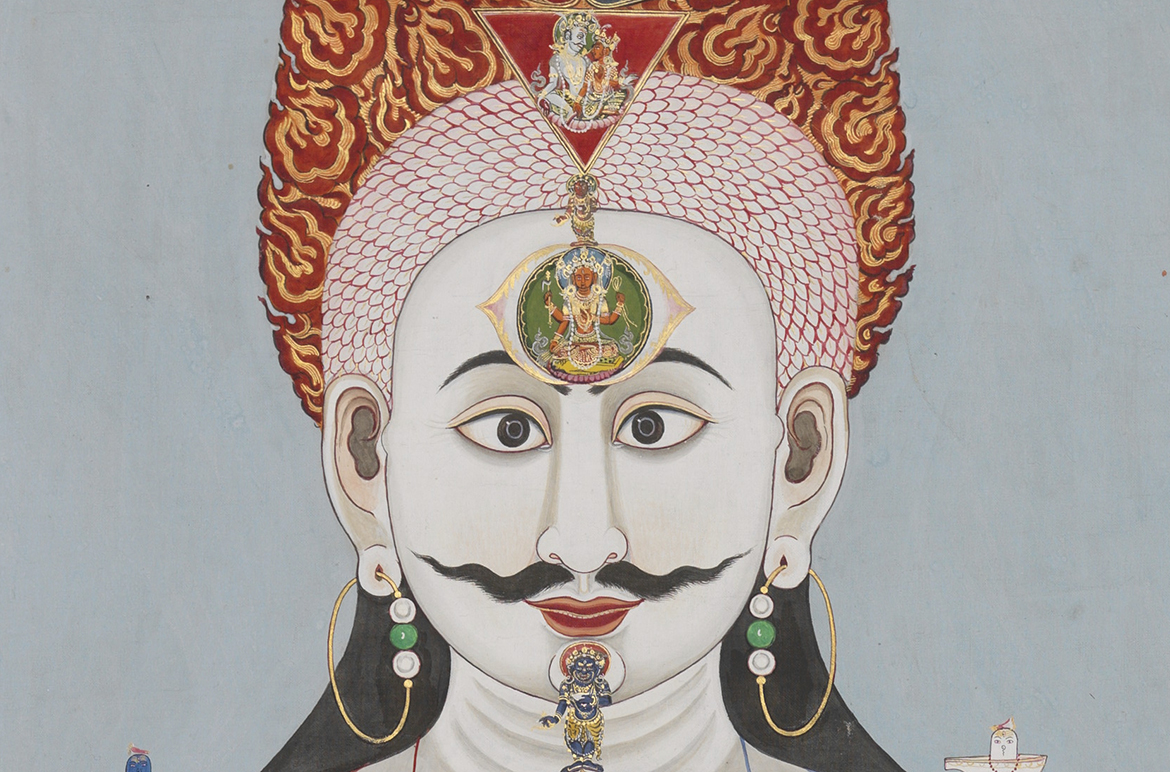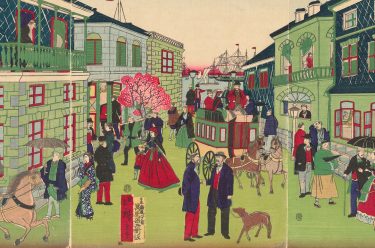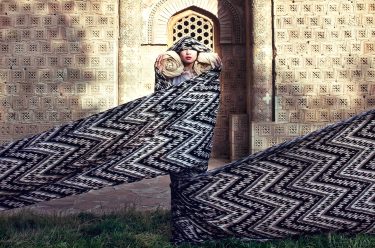Untitled (Chakraman) is a rare example of Nepalese painting. Visually striking in its scale and colour, and rich with iconography, it illustrates concepts connected to Buddhism, Hinduism, tantric principles and yoga, while depicting a great number of deities and incarnations.
The central figure is a yogi (male yoga practitioner) showing the inner structure of the body that presents an aid for yoga and meditation in transforming the body into an enlightened spiritual force. The Hindu yogic system generally believes in the seven chakra (Sanskrit for ‘wheel’) system which are lined along the spine. The serpent goddess Kundalini is believed to lie coiled in the pelvic region until the energy is awakened and ascends through the opening of the lotus petal–lined chakras, each with its own colour and deity. Travelling from the root or base chakra in the pelvic floor, the force travels through the sacral chakra (governing sexuality), naval, heart, throat and brow chakra, ending in the crown chakra, which in this painting connects to a flaming crown where the chakras continue ascending toward heaven. The composition is strictly symmetrical and coded (some tantric paintings resemble mathematical diagrams), the face echoes the style of Mughal miniature painting, and the body is dotted with lingham-yoni, the abstract, phallic symbols representing male and female energy.

In the lower section of the painting, an array of gods and incarnations connect the yogi to the earthly realm in veneration of Vishnu, the preserver of the universe. The serpent Vasuvi, a transitory manifestation of Vishnu balances above the earth goddess Prithvi, who rests on the boar-headed avatar Varaha. Below is the golden tortoise Kurma, the second avatar of Vishnu, under which Vishnu lies in an ocean, on a multi-hooded serpent with a chauri (fly-whisk) bearer and his consort Lakshmi at his feet. At the base is a ten-armed goddess holding the eight weapons of Vishnu, supported by a frog standing on two spheres representing the sun and moon.

Newar artists of the Kathmandu valley were considered masters in depicting the metaphysical world and tantric art, which was an important didactic instrument in illustrating cosmic order and inner energies. Primarily through religion, Nepalese artists borrowed many of their styles from traditions in India, however as these rapidly evolved with the many courts and artistic centres in India, the Nepalese often continued and refined styles further than their Southern neighbours. Both Nepalese painters and sculptors were hugely influential to Tibetan art, with envoys of artists employed to decorate the Buddhist temples in Tibet and sometimes further into China. Untitled (Chakraman) is a fascinating example of the rich artistic traditions of Nepal, where the confluence of Hinduism and Buddhism inspired great accomplishments and their position amongst Himalayan neighbours offered varied artistic exchange.
Tarun Nagesh is Associate Curator, Asian Art, QAGOMA
‘Chakraman’ late 19th century

#QAGOMA


I recent visited Brisbane from Washington, DC and was very glad I took the opportunity to visit your museum. I was particularly struck by this Chakraman piece. This is an extraordinary and important example of this genre of yogic art. (Currently there is an excellent temporary exhibition of yogic art at the Smithsonian Sackler Gallery in Washington, DC) I respectfully suggest to Mr. Nagesh that the red and white spheres at the bottom of the piece represent Ida and Pingala, the dual red and white kundalini energies. Thank you for sharing this piece at the museum and through your blog.
The design of this “Charkaman” Yogi is quite unique indeed. It would be nice to appreciate every detail and each deity. I really hope to have the opportunity to see this stunning artwork with my own eyes one day.
Namaste.
Its magnificent!
Cảm ơn